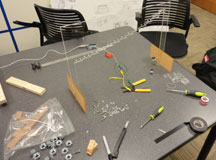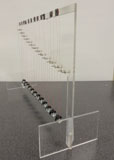Harmonic Beauty
Do you know what a pendulum wave is? A few months ago, I didn’t either. But one day someone showed me a video of it online and I suddenly realized that I had to build one.
A pendulum wave is a series of pendulums hung in a line, each with a slightly different length (from attachment point to bob) according to a specific ratio. For example, if your first pendulum hangs 10cm below it’s attachment point, the next might hang 15/16ths of that height (or 9.375cm), the next would be 14/16th of the 10cm height, the next 13/16, etc. Each subsequent pendulum length relating back to the first length. Using a spreadsheet, it’s easy enough to calculate these ratios for any set of lengths.
Because the length of a pendulum determines its period (how long it takes to oscillate from one side to the other and back), each pendulum in our line has a slightly different period. And because you created the lengths precisely according to this ratio, the periods also have a precise relationship.
When you create a series of these pendulums, you create some amazingly cool patterns. The pendulums will cycle in and out of sync repeatedly until friction slows them down to a stop. Or, if you use a computer to program them, you can have it loop endlessly. Here I’ve included a short clip showing one cycle of twelve pendulums moving out of sync and back It takes a minute, but this is at 1/4th speed. This program was written and recorded from Processing software, available free online. Email me if you’d like the source code.
Once I had this working in a digital model, it was time to get physical. I decided to laser cut the stand for the pendulums, to take as much of the guess work as possible out of the heights. Of course, there was still some error due to inaccuracy in hanging each bob, which is why in this physical model, the pendulums do not come back into sync perfectly. This video is shown at 1/8th speed.
Finally, I also included blue LEDs in each pendulum, to highlight the motion. The suspension wires for each bob did double-duty as the leads for the LED power.
In the next version of this project I will definitely use something like guitar tuning screws to allow for precise tuning of each pendulum. This was a fun initial foray into building a sculpture which gets its beauty from highlighting a natural phenomenon.




My students would love to watch this once we start our unit on energy and waves! Would you mind if I showed it to them?
Hi Sarah –
Absolutely! Feel free to show them. I thought the natural phenomenon was fantastic and it really is not too hard to build one either.
Thanks for stopping by to check it out.
Nice. Looks like something you can build into a nightclub.. imagine if you have a giant human controlled sized pendulum wave!!.. :O